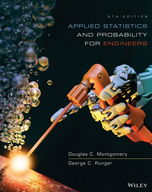Sample Size Determination. In the single-factor completely
Chapter 13, Problem 77MEE(choose chapter or problem)
Sample Size Determination. In the single-factor completely randomized design, the accuracy of a100\((1-\alpha) \%\) confidence interval on the difference in any two treatment
means is
\(t_{\alpha / 2, a(n-1)} \sqrt{2 M S_{E} / n}\)
(a) Show that if A is the desired accuracy of the interval,
the sample size required is
\(n=\frac{2 F_{\alpha / 2,1, a(n-1)} M S_{E}}{A^{2}}\)
(b) Suppose that in comparing \(a=5\) means you have a preliminary estimate of \(\sigma^{2}\) of 4. If you want the \(95 \%\) confidence interval on the difference in means to have an accuracy of 2, how many replicates should you use?
Equation Transcription:
Text Transcription:
(1-\alpha) \%
\(t_\alpha / 2, a(n-1)} \sqrt 2 M S_E / n)
\(n=2 F_\alpha / 2,1, a(n-1)} M S_E A^2)
a=5
\sigma^2
95%
Unfortunately, we don't have that question answered yet. But you can get it answered in just 5 hours by Logging in or Becoming a subscriber.
Becoming a subscriber
Or look for another answer
